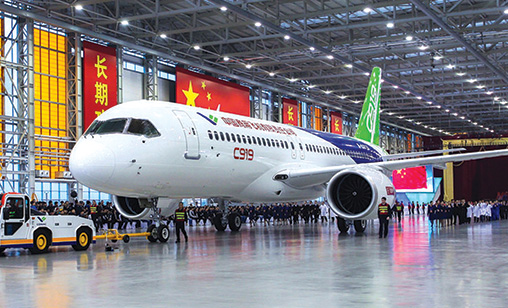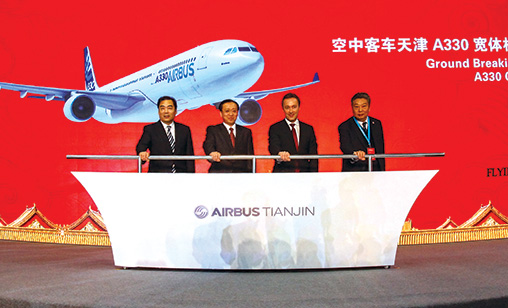Year in Review
China stalking first world aerospace manufacturers
December 1st 2017
It was years behind schedule, but China’s first commercial single-aisle jet, the C919, made its maiden flight in May, several years beyond its original launch deadline. Read More » It is expected to enter into service in 2020 and already has a 300 plus order book almost exclusively from Mainland airlines and lessors.
Hardly noticed amidst the hype that surrounded U.S. President Donald Trump’s visit to China in November was the news that the U.S. Federal Aviation Administration (FAA) had signed an airworthiness certification deal with China. It was a decision that will open the door to sales of Chinese aerospace components to the U.S. and also to several countries that accept FAA validation documents.
 |
Most of the world’s airlines buy jets certified by credible agencies, notably the FAA and the European Aviation Safety Agency (EASA). Until now, Chinese certification was excluded from such standing beyond the Mainland.
The FAA agreement will grant China “comprehensive peer recognition” as an aerospace supplier, the Civil Aviation Administration of China (CAAC) declared. Previously, all American aviation products were eligible for use in China, but only a handful of Chinese aviation products could enter the U.S.
The breakthrough boosted Beijing’s hopes of being a global supplier of commercial jet products in a market presently dominated by Airbus, Boeing and Embraer. All Chinese-built aerospace components can potentially be sold to U.S. customers because of the “mutual recognition” enshrined in the new agreement, said the CAAC.
Aircraft certified by China will not automatically be allowed to fly in U.S. airspace, the FAA said. “These products are subject to a validation process defined in the agreement”, which could still include a full technical review.
A strong presence in Western aerospace markets may be years away for China, but its determination to be a force in global aerospace was emphasized with a decision by China and Russia to jointly build a green sheet wide body jet, the C929. The joint venture partners have targeted a maiden flight and first delivery of the aircraft for 2025 to 2028.
In a separate re-structuring of global aerospace manufacturing, Airbus surprised the industry in October with its announcement that it would take a 50.01% holding in Bombardier’s stuttering C Series jet programme. The timing of the announcement, with completion of the deal expected mid next year, came shortly after the U.S. government said it would impose duties of up to 300% on Canadian jets after Boeing accused Bombardier of price dumping in the sale of its jets to Delta Airlines.
Airbus said the C Series jet would be assembled at its plant in Alabama, but whether this will allow Bombardier to avoid the proposed duties has yet to be seen.
In 2017, Airbus added to its presence on the Mainland with the inauguration of its first wide body Completion & Delivery Centre for the A330 in Tianjin, the economic zone where the Toulouse manufacturer has been operating its successful joint venture A320 Final Assembly Line (FAL) since 2008. Airbus partners in the A320 FAL are the Tianjin Free Trade Zone and Chinese aerospace conglomerate AVIC.
 |
Since the A320 FAL opened, Airbus has seen a rapid increase in the sale of its aircraft on the Mainland. At the September launch the A330 C&DC, Airbus hinted that if there were sufficient orders an A350 C&DC could follow on the Mainland.
A few months earlier, Boeing Commercial Airplanes confirmed its first joint assembly line in China would be built in Zhoushan, Zhejiang provice. The joint venture, with the Commercial Aircraft Corporation of China, is the first Boeing facility to be built outside the U.S, and is a change of strategy for Boeing.
Construction began in May with the first aircraft expected to be delivered to customers by December next year. The island facility will complete cabin outfitting, painting, maintenance and delivery of B737s, with the venture expected to work up to delivery of 100 of the aircraft annually.
Both Boeing and Airbus have launched new aircraft this year. In March, the B78-10 successfully completed its maiden flight followed by the B737MAX in April. The latest version of Airbus’s A330 wide body, the A330neo first flew in October.
The year did not start well for Rolls-Royce when the engine maker admitted it had paid almost $900 million to settle bribery and corruption charges that had dogged the company for years. Investigators in more than a dozen countries sifted through allegations to prove that Rolls-Royce used middle men to pay millions of pounds sterling in bribes to more than a dozen airlines, including Thai, Indonesian and Chinese carriers, to secure commercial and military aircraft engine orders.
However, with orders rolling in for new aircraft from around the world, business was good for the engine manufacturers, who wrote billions of dollars in new business. Although the well-publicized problems with Pratt & Whitney’s new geared turbofan engine (GTF) continued to cause delays to deliveries of Airbus’ A320neo. Some, according to Airbus chief salesman John Leahy, were lined up on the tarmac “like gliders” awaiting delivery. Towards the end of the year, the problem was easing as fixes were put in place to resolve the issue.
A powerhouse of the digital economy, China’s Shenzhen, which borders Hong Kong’s northern boundary, has been chosen as the site for the Airbus China Innovation Centre. Known as the Silicon Valley of China, Shenzhen is the home of Tencent Holdings, whose market valuation is close to that of Facebook, and also is the home of several multi-billion dollar new economy companies in Greater China. Airbus China Innovation Centre CEO, Luo Gang, and Shenzhen leaders announced last month they had “signed a cooperative framework agreement with Invest Shenzhen to establish a long-term strategic partnership to accelerate innovation and the shape of future flight”. The cooperation agreement has three major goals: * Accelerate R&D, applications and industrialization of the inflight experience, connectivity, new energy and urban air mobility. * Cultivate an integrated hardware and software ecosystem by relying on Shenzhen’s high end aviation R&D and advanced manufacturing industry value chain. * Establish a technological innovation system with the support of the city innovation ability, talent resources and business environment. “The innovation centre will benefit from the advantages of policy planning, talent resources and a favourable investment and financing environment in Shenzhen to impact global aviation innovation,” Luo said. “The city boasts global competitive advantages in technology, research and development, industrialisation and international expansion” Initiatives at the recently established centre include autonomous flight, urban air mobility (UAM), inflight experience and interaction with leaders in industries relevant aerospace. Airbus also has a research centre, A3, in northern Califormia’s Silicon Valley. |